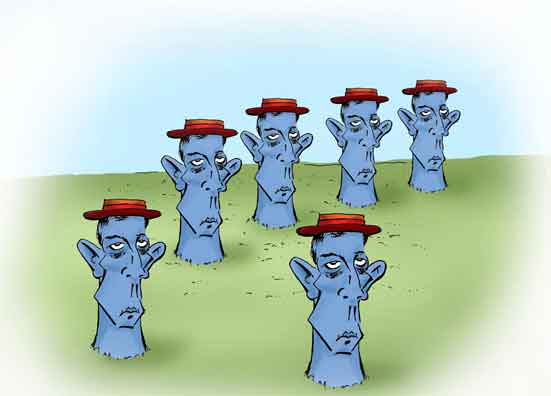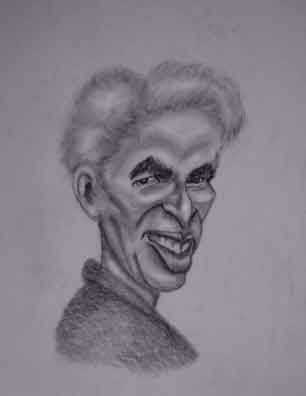Buster Keaton
The Great Stone Face

Buster Keatons
The Great Stone Face
What surprises viewers is that when interviewed in their later years how articulate the old silent screen actors were. But that makes sense. Early actors had trod the boards and you didn't get the job if you just made funny faces and fell down. A few of the most notable actors who started in films before sound - and who most people don't know were in silent pictures - are Joan Crawford (Lady of the Night), Boris Karloff (The Bells), Clark Gable (The Merry Widow), Gary Cooper (Riders of the Purple Sage), Edward G. Robinson (The Bright Shawl), and John Wayne (Four Sons). Yes, the Duke made silent pictures.
And of course, there's Charlie Chaplin. His film The Great Dictator was a talkie, although much of the humor was visual. Another Chaplin film, Limelight was also popular outside the United States where it was suppressed due to Charlie's politics and other reasons.
Buster also made the transition from silent to talkies and although it's strictly true that his career fell off, you wouldn't know it by looking at his filmography. He appeared in motion pictures or on television shows in almost every year from 1917 to 1966 and often multiple times. Some of the more notable movies where he put in an appearance were Around the World in 80 Days, A Funny Thing Happened on the Way to the Forum, and How to Stuff a Wild Bikini.
Buster is arguably second only to Chaplin in importance of early film comedy. He was born into a theatrical family. His dad and mom were both actors and they incorporated Buster into the act as soon as he could walk. The act was very physical. In a typical skit Buster would misbehave and then his father would pick him up and throw him around. Buster thought it was great fun and learned how to take falls without getting hurt.
The Keatons were part of the troop that included a magic act by a young Harry Houdini. The story is that Harry gave Buster - whose real name was Joseph - his nickname. Unlike most good stories, this one has an authoritative source, Buster himself. So it just might be true.
By the time Buster was twenty, films were beginning to replace live stage performances as mass entertainment. Buster was pretty well known as a stage actor and with his friendship with Roscoe "Fatty" Arbuckle had the contacts needed for a smooth transition. He started working as Fatty's sidekick.
Buster said that he really never had a script. They would work out the beginning and end of the film and then fill in the gags as they went along.
The actors did speak lines in silent movies. The reason it's not always noticeable is that often when the actor began to deliver the lines, after the first word, the cut would be made to the dialog card. Then after there was enough time for the viewers to read the line, they would return to the actor who was speaking the last syllables. This saved time and besides it looks pretty ridiculous to see people in white pancake makeup looking into a camera and moving their mouths for a minute.
Buster tried to minimize dialog and even said that he and Charlie had a bet as to who could make a film with the fewest number of dialog cards. Buster said Charlie won the bet as he made a feature film with 21 cards. He, Buster, had a film with 23.

Charlie Chaplin
He won the bet.
Buster developed the Great Stone Face persona when he was performing with his folks because he found out that if he laughed doing a stunt, the audience didn't. He also found that sticking a gratuitous gag in the plot wouldn't always work either. In one film he was shipwrecked on an island and he had to repair the hull from beneath the water. So he put on a deep sea diving outfit. But when he gets underwater he stopped to direct a school of fish like a traffic cop.
Buster and the crew thought this would be hilarious. But when they showed the film to a test audience no one laughed. However, if they took the scene out of context and showed it simply as a trailer, the crowd roared. So the stunts had to be part of the plot, otherwise the audience would be thinking too much about how it fit in with the story.
Only rarely did Buster use a stunt double. He thought the actor should get the laughs, not a stand in. But some of the stunts were dangerous. In one of his films Buster is hiding at the end of a railroad car when another one is pushed up to hook on. The stunt went off OK, but similar circumstances resulted in maimed and killed railroad workers. And in another scene he walks along the top of moving boxcars to grab onto the spout of a water tower before dropping to the ground. This would certainly not be allowed today where stuntmen are sometimes used even when an actor has to jump down from a chair.
Television audiences got a new look at Buster in the 1960's when he was the main character in the Twilight Zone episode "Once Upon a Time". He played a disgruntled citizen of 1890's New York who is certain that the country is going downhill with the rising costs, the din of the towns, and massive government spending. He then finds a special helmet that transports him to the modern 20th century. After an afternoon in 1960, he decides things weren't so bad in the old days after all.
The parts of the story in 1890 were silent with the dialog cards and piano background music. When Buster was transported to the 1960's the performance used spoken dialog and current filming conventions. Buster meets an unscrupulous inventor (played by actor Stanley Jones of Trouble with Tribbles fame) and who wants to steal the helmet. But Buster does manage to get back to his own time where again the scenes are silent.
What may seem a bit odd to newer fans of silent movies who see this episode is how fast and jerky the action is. This effect is deliberate as the silent scenes were intended to look like a silent movie to a 1960's audience. Silent movies were filmed at a slower speed than mid-20th century cameras and so when shown on the screen with modern projectors the action was faster than filmed. Today playback speeds are more easily corrected and silent movies are usually shown at the proper speed.
The last movie Buster made was Film. This was Irish playwright Samuel Beckett's sole excursion into screenwriting. This is a very 1960-ish "art" film and so most people won't really know what's going on. Buster said he didn't know what was going on either.
The 20 minute almost entirely silent film took three weeks to shoot - which seems a long time since Roger Corman shot the 85 minute Pit and the Pendulum in only two weeks. But the crew were novices at film making and sometimes what they wanted to come out on film didn't. Sam himself said the film was about how Samuel Beckett loved cinema but that it wasn't his medium. Film was released in 1965 to generally unfavorable reviews and Buster died the next year.
References
My Wonderful World Of Slapstick, Buster Keaton, Samuel Charles, Da Capo Press, 1982.
"Buster Keaton: The Last Fade Out of the Great Stone Face", James Agee, Life Magazine, February 11, 1966, pp. 63 - 64.
"Interview with Buster Keaton", Studs Terkel, The Studs Terkel Program, September 5, 1966.
"When Samuel Beckett Tried to Capture the Power of Movies", Siddhartha Mahanta, The New Yorker, March 1, 2016.
Samuel Beckett, Deirdre Bair, Simon and Schuster, 1990.